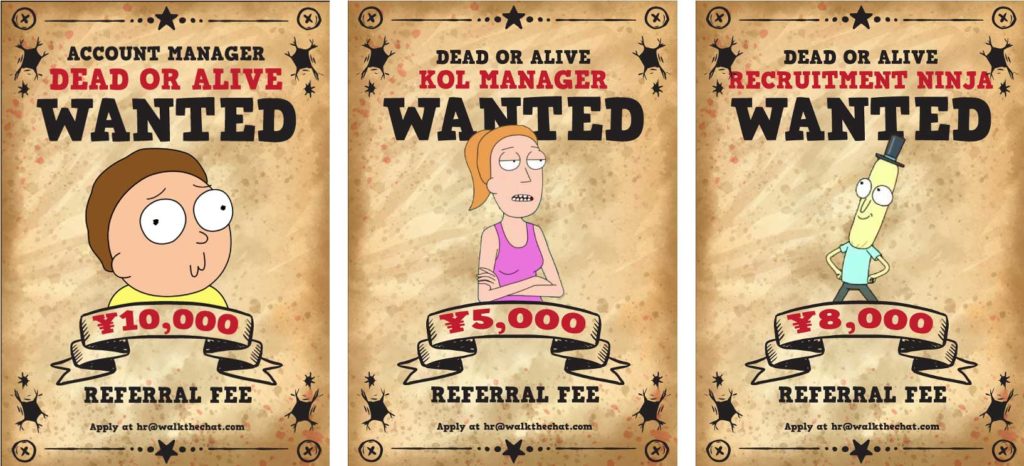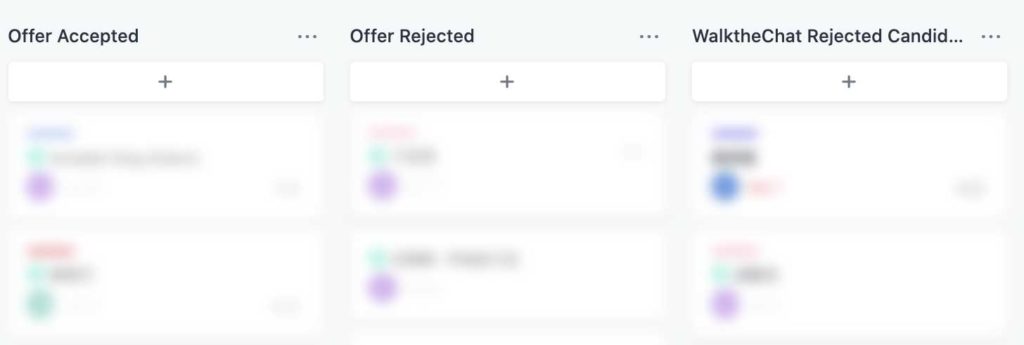Since the beginning of 2020, WalktheChat experienced accelerating growth: we became the first Shopify Sales Channel enabling sales to China, started offering Douyin and Kuaishou marketing services to our clients, and expanded our Tmall operations.
This growth came with a lot of pressure on our operations team. We quickly realized something: our recruitment process wasn’t on par with the company’s momentum.
We dived in, and from interviews with other entrepreneurs to HR books, completely revamped our hiring methodology. Here are some of the changes we implemented.
Goodbye Job Descriptions, hello Performance Profiles
The first and most momentous change we made to the recruitment pipeline was getting rid of Job Descriptions altogether.
A Typical job description usually follows the following format:
- Description of the company
- Description of the position
- Requirements for the position
- Random miscellaneous information
This format is boring and undifferentiated. Our job descriptions looked the same as any other one in the industry. Why would talented people choose us?
Taking inspiration from Lou Adler’s book “Hire with your head” (thank you Jess from Kaiterra for recommending!), we converted our old job descriptions into Performance Profiles.
What are Performance Profiles? They are not a boring list of what people will do. Instead, they are a concrete description of the KPI’s the new hire will be expected to achieve on the job.
Here’s what our old Job Description for Account Managers used to contain:
Responsibilities
- Help discuss and refine content and promotion strategy for our clients
- Work with copywriters to provide clients with outstanding content
- Be the interface between designers and clients
- Collaborate with promotion platforms (Influencers, WeChat ads, Douyin ads, etc.) in order to support our clients marketing efforts, visibility and sales
- Be the link between customer service teams and client
- Provide feedback to IT team about bugs or feature requests from clients
Instead, the performance profile takes a much more down-to-earth approach (this is just a fragment of a much longer profile):
Account manager performance objectives
- General target: launch and expand the China sales of 4 to 6 clients in the WalktheChat portfolio.
- Client strategy definition: define and adjust the strategy of the client on the Chinese market based on the client’s current presence in China, past performance, and on the evolution of Chinese digital channels. During the first 2 weeks after onboarding, conduct a detailed analysis of current clients’ performance and strategy, and provide a plan including innovative ideas of sales channels or tactics to improve client’s sales.
- Monthly client reporting: write and present monthly reports to the client detailing all actions are taken and results achieved during the previous month. Include a detailed action plan for the upcoming 1 to 3 months.
- Interpersonal skills: build a friendly relationship with all clients within the Account Manager’s portfolio. Create a trust relationship so that clients feel comfortable expressing concerns or issues.
- Influencer campaign management: work with WalktheChat’s influencer-selection team to select influencers for clients’ campaigns. Achieve between 200% to 300% average return-on-investment on sales campaigns.
This new Performance Profile approach had several benefits. First, it attracted a much higher breed of candidates. Talented candidates would get excited by the clear and demanding requirements, while subpar candidates would get overwhelmed and give up before even applying.
Another benefit is that it triggered conversations when candidates would not perfectly match the Performance Profile. In which case, we would re-work the profile to see if we could make it match the candidate.
Sometimes, it meant that we had forgotten some elements in the profile. Other times, we discovered a brand new position that we didn’t know we were trying to hire for (that is how we hired our first Revenue Manager, an expert in charge of increasing the sales of WalktheChat clients).
Provide substantial referral bonuses
We found that referral bonuses, both internally and externally, are an excellent way to source candidates. We offer between 5,000 to 10,000 RMB bonus for different positions to anyone who introduces a candidate, and we’re thinking of increasing these amounts.
Referral bonuses are great on many accounts:
- They actually do generate new applications. We had dozens of qualified applicants over 6 months explicitly coming from referrals. Some of them we hired!
- Bonuses can tilt the scale even for internal employees who would promote your company anyway. Of course, your own staff should be excited about bringing friends onboard regardless of the bonus, but a 10,000 RMB bonus is an incentive to go the extra mile. I definitely wouldn’t say no to it!
- Referral bonuses are very very cheap. Paying 10,000 RMB for a new candidate is nothing compared to a headhunter company (more on that later) that will charge 50,000 RMB and upwards for pretty much any position you would hire for.
Make it fun
Your hiring strategy should, to a large extent, reflect your culture. We had taken the first step by creating the Performance Profiles, that reflect the demanding work culture at WalktheChat.
But working at WalktheChat is not just demanding. We also offer a fun, relaxed, people-friendly working environment (our track record speaks for itself: in 6 years, only 3 people voluntarily left our company… and some of them still drop by to attend our monthly meetings!)
Given the fact that we were pretty desperate to hire, we jokingly mentioned that we would take new talents dead or alive. WalktheChat early employees are also huge Rick & Morty fans, so our new recruiting campaign was born.

Of course, we do not expect all of our new recruits to be Rick & Morty fans, or even to have heard of the show.
But even for people who haven’t seen Rick & Morty (though, really, they should) the job ads give a feeling of a quirky company, where people don’t take themselves too seriously and are overall a bit weird. That’s us.
Design a real interview process
We use to have an unstructured interview process, which had more to do with “fit” than a real assessment of capabilities. Often candidates would have the feeling of going through the same interview several times, without much coming out of it.
Instead, we started taking a much more scientific approach to interviews:
- Work history review: although most interviewers think they’re doing a work history review, they don’t. A proper work history review means to go through every job and find out what the person accomplished, what the person didn’t accomplish, the team the person worked with, why the person took the job, and any recognition they received. It means asking for detailed KPIs they achieved, and asking the candidate for a detailed org-chart of their organization. Drawing the org-chart will also help understand the detailed responsibilities of the candidate, and probe about their performance compared to their peers.
- Threat of reference check (TORC): this concept is taken from “Who: the A method for hiring” by Geoff Smart and Randy Street. After the candidate drew the org chart, we ask them the name of their line manager. Then we ask “When we will call *first name* for a reference check, what will he/she tell us about your strongest and weakest points?” When confronted with this question, candidates somehow become brutally honest and share some of their shortcomings that they would never have put forward otherwise.
- A concrete case study related to the day-to-day job: it took us a long long time to identify the right case studies for each position. For Account Managers, we ask the candidate to study the presence of one of our clients in China. We show them past campaigns and ask them to estimate the returns the client got from these campaigns We also ask for strategic recommendations. We found that case studies are also a great way for the candidate to discover the nature of the job. We try to make them as realistic and practical as possible. They are no “mind games” to test the candidate wit, but a real preview of the day-to-day work. We found that candidates who shine during the case study tend to do exceptionally once hired.
Conduct a proper reference check
The first point about reference checks is that too many companies skip them. No matter what, you should conduct reference checks.
There is a reason why reference checks get skipped. All too often, reference calls can turn into a pleasant conversation about how great the candidate is. No one likes to ruin opportunities for their former colleagues.
However, you can gather a lot of information by calling a candidate’s past employer and asking some real probing questions. Here are the types of questions we are asking during reference checks:
- What were the candidate’s KPIs in this position?
- How did they performed compared to their expected targets?
- Can you give me some examples of where the candidate took the initiative?
- How would you rank this person’s overall competence in [job-specific] area?
- How would you rank this person among other people you know at a similar position? Why is the candidate stronger/weaker?
- In which percentile of the employees is the candidate? What would it take them to move to a higher percentile? (to hear about weaknesses)
- What advice would you give this person on how he could be more effective in his next job?
- Would you rehire the candidate enthusiastically? Why or why not?
By asking job-specific questions, you will get some insights about the candidate’s capabilities. Don’t miss this crucial step.
Leverage headhunters
We hadn’t leveraged headhunters in the past, and from my conversations I realized that few entrepreneurial company do.
That is a big mistake.
We hired tremendous profiles from headhunters. And we found these few rules to help:
- Write good performance profiles. The approach described in the first part of this article is essential to work with headhunters. They have other clients, and your job ads need to stand from the crowd. Making them fun won’t hurt either. Following the steps in the first sections of this article will multiply your results from headhunters.
- Focus on the positions you are urgently hiring for. Having headhunters send you a wave of candidates for positions that you are considering on the mid-term will exhaust both your team and the headhunters. Headhunters also will stop sending you good profiles after a while if you don’t hire, so make sure you have real intent.
- Work with multiple agencies on a commission basis. We have found a great disparity in terms of profile quality between different headhunting companies. A simple way to benchmark is simply to hire a lot of them, while keeping the agreement commission-based.
Stay organized
The last thing you need to do is to stay organize. Many companies keep track of their hiring process via out of date excels that nobody has access to. Interviewers give feedback to the HR department that no one else can check, and meeting notes get lost over time.
It is crucial you keep detailed data about candidates performance during interviews. Sometimes, you will want to get back to an earlier candidate and you will have forgotten pretty much every detail of the interview. Other times, you will want to check back on the interview performance of someone you hired (usually because they’re performing exceptionally well or poorly).
The system doesn’t have to be complicated. At WalktheChat, we simply use an Asana board (but some more specialized solutions such as Recruitee also exist, although they are costly)

After each interview, be consistent about writing the reasons for rejecting the candidate or moving them to the next round. This will save you a lot of time on the long run.
Conclusion
Recruiting is hard, but it can be made easier. By designing a solid recruitment process, you will truly build a company where it feels good to work.
This article is heavily inspired by two books: “Who: the A method for hiring” by Geoff Smart and Randy Street and “Hire with your head” by Lou Adler.
Thank you also to Liam and Jess from Kaiterra for sharing insights about their own recruiting process. You can check more about their own positions via https://learn.kaiterra.com/career
And of course, WalktheChat is still hiring. Here are the links to some of our latest job openings:
And much more: designers, front-end programmers, back-end programmers… interested in joining us? Feel free to reach out!

